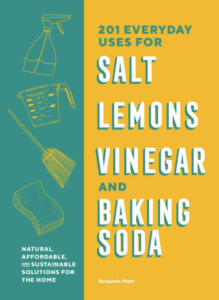
Clean every room in your house (plus use a little recipe to pamper your skin) this spring without all the chemicals. This checklist has a selection of solutions from our book using simple pantry ingredients: salt, lemons, vinegar, and baking soda. Not only is it the most affordable way to clean your home, it’s also good for your health and the health of the planet!

All-Purpose Cleanser
Every cleaning arsenal requires a multipurpose cleanser capable of handling a wide variety of household cleaning challenges, from dirty stovetops to coffee tables, grease-stained clothing to bathroom sinks, and car interiors to most countertops (but not natural stone, many types of which are easily damaged by acids such as vinegar). This simple preparation makes a great-smelling, highly effective cleaning solution for countless situations.
1 Mix 3 large strips of lemon peel with 2 cups (500 mL) white vinegar in a glass jar with a tight-fitting lid. Let this mixture stand for 4 weeks, giving it a good shake every couple of days.
2 Strain the mixture through a fine-mesh stainless-steel strainer or cheesecloth and pour into a clean 16-ounce (500 mL) glass spray bottle.
NOTE: If you don’t have time to wait for the lemon peels to steep, substitute 5 to 10 drops lemon essential oil; the spray will be ready to use immediately.

Rug and Carpet Deodorizer
It’s odor-absorbent baking soda to the rescue! Just keep in mind that this treatment is for regular odor control. Depending on how much use your rug or carpet gets, you will want to follow this simple deodorizing procedure every four to eight weeks to keep them from smelling like a sweaty teenager.
1 Begin by vacuuming the rug or carpet you want to deodorize.
2 Then, using a flour sifter or fine-mesh stainless-steel strainer, sprinkle 1 cup (250 mL) baking soda (or more, depending on the size of the rug or carpet) across the area. Allow the baking soda to sit on the rug for a minimum of 3 hours, though overnight is best—just make sure to limit human and animal traffic during this period. Finally, vacuum up the baking soda.
NOTE: This procedure works just as well on upholstered furniture.

Closet Freshener
The clothes closet is the archive of our daily attire—from shoes to shirts, dresses to jackets, much of our apparel lives in there. This is why it’s important to give these hardworking garments a clean, and clean-smelling, environment to call home.
1 Remove all items from the closet and set them aside before sweeping or vacuuming the floor of the closet, using the appropriate attachment.
2 Lightly spray the walls of the closet using All-Purpose Cleanser (above). Wipe up the spray, working top to bottom, with a clean, lint-free cloth.
3 In a small bowl, mix ¼ cup (60 mL) baking soda with 5 to 10 drops essential oil of your choice (I recommend sandalwood or lavender). Sprinkle the scented baking soda over the floor of the closet and let it sit for 30 minutes to 1 hour. Vacuum up the baking soda and replace all your clothes and shoes.

Grout Stain Remover
The grout between tiles are the worry lines of the bathroom, revealing the weight of the world the tiles carry on their tiny ceramic or glass shoulders. Because the walls around the bathtub and shower tend to be highly humidified several times a day, mold and bacteria love to start new colonies nestled in the cracks between those tiles. To keep these worry lines from growing into something much worse, let salt and lemons come to the rescue.
1 In a small bowl, mix 1 cup (250 mL) strained lemon juice and 1 cup (250 mL) salt. Apply the paste to the grout with a clean, damp sponge, pressing it into the cracks and scooping up more paste as necessary. With a stiff scrub brush, scour every vertical and horizontal line of grout, focusing on the trouble areas around the faucet handles and under the showerhead or wherever mold has begun to grow. Rinse with cold water.

Laundry Softener
There are a couple of benefits to using a laundry softener, besides the obvious: it helps reduce wrinkling and reduces friction in the fibers, resulting in less wear and tear on clothes over time. Commercial softeners and dryer sheets do a good job at these tasks, but they also leave a fine, oily residue behind. For most clothing this is not a problem, but in technical fabrics of the sort athletic garments are made of, this residue can compromise its moisture-wicking properties. It can also make white clothes look a little dingy. Happily, this homemade preparation is suitable for all kinds of fabric.
1 In a clean, resealable 16-ounce (500 mL) glass jar, thoroughly mix ¾ cup (375 mL) Epsom salt with ¾ cup (375 mL) baking soda. Add 2 tablespoons (30 mL) of this mixture to each load when you add the detergent.

Barbecue Grill Cleanser
Though nothing symbolizes the warmer months of the year like the smell of barbecue wafting through the air, lots of home cooks use their grills year-round. If you frequently prepare meals on your barbecue, you know the importance of keeping the racks as clean as possible (just as you probably also know that it is not safe to scrape the grills with a wire brush—small bits of wire can break off and become lodged in the food you cook next).
1 In a clean 16-ounce (500 mL) glass spray bottle, mix 1 cup (250 mL) water and 1 cup (250 mL) white vinegar. Replace the spray nozzle and shake well.
2 Remove the greasy cooking grates from the grill and lay them on top of flattened-out cardboard or newspaper. Sprinkle the grates liberally with baking soda on both sides. Spray the grill with the water-vinegar spray until the baking soda begins to foam. Wait 10 minutes before using a balled-up sheet of aluminum foil to scrub both sides of the grates. Using a clean rag, wipe any remaining grime and moisture off the grates. Apply grapeseed or canola oil to both sides of the grates with a paper towel or rag to season.

Exfoliating Sugar Scrub
If you have particularly sensitive skin, or if you are exfoliating your face, you may want to use a sugar-based scrub. Sugar granules are easier on the skin because they are rounder than sea salt granules and dissolve more quickly when they come into contact with water. In general, you should not use a physical exfoliant such as salt or sugar more than two or three times per week.
1 In a medium bowl, mix 1 cup (250 mL) table sugar, ¼ cup (60 mL) virgin coconut oil, 5 drops lemon essential oil (or other scent of your choice), and 1 tablespoon (15 mL) fine citrus zest (lemon, orange, or grapefruit work well). Place the mixture in a clean, resealable glass jar. Before you step out of your next bath or shower, or after you wash your face at the sink, apply a handful of sugar scrub to your skin, rubbing gently using a circular motion. When you are done, rinse away any residue with cool water.
NOTE: Because it is loaded with minerals that are good for your skin, unrefined cane sugar makes an excellent scrub too, but it is quite angular and coarse, so it may be better suited to your body than your face if you have sensitive skin.
Get the book!
 201 Everyday Uses for Salt, Lemons, Vinegar, and Baking Soda by Benjamin Mott
201 Everyday Uses for Salt, Lemons, Vinegar, and Baking Soda by Benjamin Mott
Save money on home cleaning products with 201 natural cleaning solutions that use four simple, versatile, and inexpensive ingredients: salt, lemon, vinegar, baking soda, and olive oil. This is an essential reference for anyone interested in thrifty, natural, and sustainable living! This practical book will guide you through 100s of recipes, broken down by the area of the house, with easy instructions. Home cleaning (both indoors and outdoors), personal hygiene and grooming, pet care—this is an essential reference for all parts of your life that you will reach for again and again!




